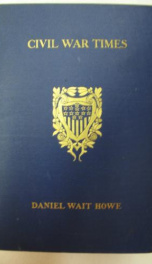civil war times 1861 1865

Purchase of this book includes free trial access to www.million-books.com where you can read more than a million books for free. This is an OCR edition with typos. Excerpt from book: CHAPTER THREE CAMP, MARCH AND BATTLE In the general histories of the Civil War, and in the histories of great campaigns and battles, we get much information about noted generals, military strategy, and tactical maneuvers, but we gain a very imperfect idea of a soldier's daily life. Some phases of it, as seen in camp, on the march, and in battle, deserve fuller attention before going further in this narrative. When it was expected that a regiment would remain in one locality for a considerable period, camp was regularly laid out according to prescribed military regulations, with narrow lanes, on each side of which were the tents of the enlisted men. At the head of each lane were the tents of the line officers, the captains and lieutenants, and in rear of them were those of the regimental officers. In the first year of the war, tents in the shape of a letter A were furnished for the enlisted men, and wall tents for the line officers. The former were secured by ropes fastened to pegs driven into the ground. Small trenches were dug around them to keep out the water in rainy weather. If boards could be found they were floored; otherwise beds were made on the ground. There was no way of heating them and incold weather the fire was made in front, the men sleeping with their feet to the fire. The tents of the officers were provided with flies which were erected in the rear and were generally used as a sort of kitchen in which the officers ate their meals. The tents of the regimental officers were similar to those of the line officers but were larger and better. The enlisted men's tents were found to require too many wagons to haul them and, in 1862, what were familiarly known in the western army as "dog-tents" were introduced, the /9th getting its first supply while in camp at... --This text refers to an alternate Paperback edition.
Info about the book
Author:
Series:
Unknown
ISBN:
0809448130
Rating:
5/5 (4)Your rating:
0/5
Languge:
English
Users who have this book
Users who want this book
What readers are saying
What do you think? Write your own comment on this book!
write a commentif you like civil war times 1861 1865 try:
Other books by this author
Do you want to exchange books? It’s EASY!
Get registered and find other users who want to give their favourite books to good hands!




